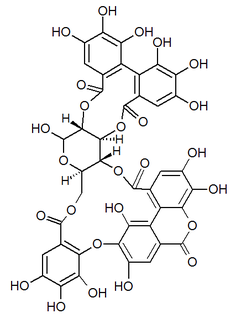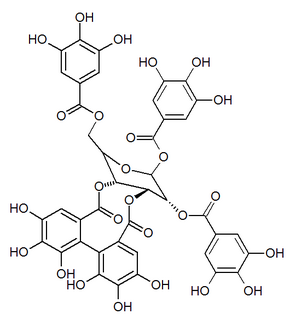
Glucose is a simple sugar with the molecular formula C6H12O6. Glucose is the most abundant monosaccharide, a subcategory of carbohydrates. Glucose is mainly made by plants and most algae during photosynthesis from water and carbon dioxide, using energy from sunlight, where it is used to make cellulose in cell walls, the most abundant carbohydrate in the world.
Hydrolysis is any chemical reaction in which a molecule of water breaks one or more chemical bonds. The term is used broadly for substitution, elimination, and solvation reactions in which water is the nucleophile.
Carbohydrate metabolism is the whole of the biochemical processes responsible for the metabolic formation, breakdown, and interconversion of carbohydrates in living organisms.

Tannic acid is a specific form of tannin, a type of polyphenol. Its weak acidity (pKa around 6) is due to the numerous phenol groups in the structure. The chemical formula for commercial tannic acid is often given as C76H52O46, which corresponds with decagalloyl glucose, but in fact it is a mixture of polygalloyl glucoses or polygalloyl quinic acid esters with the number of galloyl moieties per molecule ranging from 2 up to 12 depending on the plant source used to extract the tannic acid. Commercial tannic acid is usually extracted from any of the following plant parts: Tara pods (Caesalpinia spinosa), gallnuts from Rhus semialata or Quercus infectoria or Sicilian sumac leaves (Rhus coriaria).
Tannase is a key enzyme in the degradation of gallotannins and ellagicitannins, two types of hydrolysable tannins. Specifically, tannase catalyzes the hydrolysis of ester and depside bonds of hydrolysable tannins to release glucose and gallic or ellagic acid.

Sugars in wine are at the heart of what makes winemaking possible. During the process of fermentation, sugars from wine grapes are broken down and converted by yeast into alcohol (ethanol) and carbon dioxide. Grapes accumulate sugars as they grow on the grapevine through the translocation of sucrose molecules that are produced by photosynthesis from the leaves. During ripening the sucrose molecules are hydrolyzed (separated) by the enzyme invertase into glucose and fructose. By the time of harvest, between 15 and 25% of the grape will be composed of simple sugars. Both glucose and fructose are six-carbon sugars but three-, four-, five- and seven-carbon sugars are also present in the grape. Not all sugars are fermentable, with sugars like the five-carbon arabinose, rhamnose and xylose still being present in the wine after fermentation. Very high sugar content will effectively kill the yeast once a certain (high) alcohol content is reached. For these reasons, no wine is ever fermented completely "dry". Sugar's role in dictating the final alcohol content of the wine sometimes encourages winemakers to add sugar during winemaking in a process known as chaptalization solely in order to boost the alcohol content – chaptalization does not increase the sweetness of a wine.
A gallotannin is any of a class of molecules belonging to the hydrolysable tannins. Gallotannins are polymers formed when gallic acid, a polyphenol monomer, esterifies and binds with the hydroxyl group of a polyol carbohydrate such as glucose.
A hydrolyzable tannin or pyrogallol-type tannin is a type of tannin that, on heating with hydrochloric or sulfuric acids, yields gallic or ellagic acids.
The ellagitannins are a diverse class of hydrolyzable tannins, a type of polyphenol formed primarily from the oxidative linkage of galloyl groups in 1,2,3,4,6-pentagalloyl glucose. Ellagitannins differ from gallotannins, in that their galloyl groups are linked through C-C bonds, whereas the galloyl groups in gallotannins are linked by depside bonds.

Stachyurus is the only genus in the flowering plant family Stachyuraceae, native to the Himalayas and eastern Asia. They are deciduous shrubs or small trees with pendent racemes of 4-petalled flowers which appear on the bare branches before the leaves. The plants have leaves with serrate margins.

Tellimagrandin II is the first of the ellagitannins formed from 1,2,3,4,6-pentagalloyl-glucose. It can be found in Geum japonicum and Syzygium aromaticum (clove).

Glucogallin is chemical compound formed from gallic acid and β-D-glucose. It can be found in oaks species like the North American white oak, European red oak and Amla fruit.

Condensed tannins are polymers formed by the condensation of flavans. They do not contain sugar residues.

Terflavin B is an ellagitannin, a type of hydrolysable tannin. It can be found in Myrobalanus chebula, the black chebulic, and in Terminalia catappa, the Indian almond.

Casuarinin is an ellagitannin. It is found in the pericarp of pomegranates. It is also found in Casuarina and Stachyurus species and in Alnus sieboldiana.

Lambertianin C is an ellagitannin.

Alnusiin is an ellagitannin found in Alnus sieboldiana.

Geraniin is a dehydroellagitannin found in geraniums. It is found for instance in Geranium thunbergii, which is one of the most popular folk medicines and also an official antidiarrheic drug in Japan. It can also be found in the rind of Nephelium lappaceum (rambutan).

Nupharin A is an ellagitannin found in Nuphar japonica. It is a molecule with three gallic acid units and one hexahydroxydiphenic acid unit attached to a glucose residue. It is an isomer of punicafolin and tellimagrandin II.

Mallojaponin is a hydrolysable tannin found in the bark of Mallotus japonicus. This compound contains the moiety elaeocarpusinic acid, an oxidized hexahydroxydiphenic acid group which reacted with a dehydroascorbic acid molecule. It also contains a valoneic acid and a gallic acid moieties linked to a glucose molecule.














